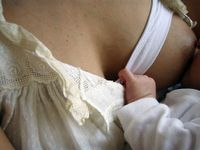Nursing bra
A nursing bra is a specialized brassiere that provides additional support to women who are lactating and permits comfortable breastfeeding without the need to remove the bra. This is accomplished by specially designed bra cups that include flaps that can be opened with one hand to expose the nipple. The flap is usually held closed with a simple clasp or hook.
Purpose
A nursing bra is designed to provide quick and easy access to the breast for the purpose of breastfeeding an infant. It typically has flaps or panels that can be unclipped and folded down or to the side with one hand. Nursing bras can be worn under a variety of outer garments.
Changes during pregnancy
Measurements for an appropriate nursing bra can be performed by a lactation consultant. Women can choose nursing bras with strong side and under cup support and an extra-wide back for optimal support. Nursing bras usually have up to four rows of hooks in the rear closure to allow the woman to adjust her band size to a limited extent. Experts recommend a soft-cup bra made of a blend of cotton and Lycra with cups that stretch to accommodate changes in breast size. Most women buy two or more nursing bras so they can alternate between them. Small-breasted women who don't usually wear a bra may choose to wear a nursing bra to support their larger breasts or simply to prevent milk from leaking onto their clothes.
Breast sizes change
A woman's breasts grow during pregnancy, usually 1 to 2 cup sizes, and potentially several cup sizes. A woman who wore a C-cup bra prior to her pregnancy may need to buy a larger bra while nursing. Once the baby is born and about 50 to 73 hours after birth, the mother will experience her breasts filling with milk (sometimes referred to as “milk coming in”) and at that point changes in the breast happen very quickly. Once lactation begins, the woman's breasts swell significantly and can feel achy, lumpy, and heavy (which is referred to as engorgement).
Changes during nursing
To provide proper support and fit, to facilitate nursing, and to avoid engorged breasts or other complications that prevent an infant from nursing effectively, it is important to wear nursing bras that fit well. When a woman wears a bra that is too tight, her milk supply may be reduced, and she can experience plugged milk ducts and an extremely painful infection called mastitis. Mastitis can physically and emotionally affect the mother's ability to breastfeed.
Types of nursing bras
There are an increasing variety of nursing bras designs, including soft cup, underwire, seamless, and lounging styles. Some nursing bras can also serve as sports bras, allowing a nursing mother to exercise more easily. Some outerwear like tank tops and T-shirts have nursing bras that are built into the garment, and there are also padded and plus-size nursing bras. Some experts advise against wearing an underwire nursing bra because it can restrict the flow of milk and cause mastitis. Most nursing bras have traditionally been white, but manufacturers now offer an increasing selection of colors and styles, including brown, teal, floral, and floral animal prints, and some are accessorized with lace and ribbon.
Different manufacturers use different methods for fastening the flap to the cup, including squeeze, snaps, clasps, and hooks. Most nursing bras are designed with cup flaps that fasten at the apex of the bra, at the point where the shoulder straps attach, allowing the mother to simply pull the top half of the cup down to facilitate access to the nipple. Other designs include flaps that fasten between the cups at the center of the bra, zippers under each cup, and a cross-over design that allows the woman to slip her breast out. Experts recommend that before buying a nursing bra women should try on the bra and experiment with opening the flap with one hand. Some designs utilizing stretchable fabric are suitable for smaller-breasted women, allowing them to pull the entire bra up over the breast to facilitate nursing.
Experts recommend nursing bras that are stretchy, absorbent, and don't bind the breasts in any way that could interfere with milk flow. Women are recommended to wear a bra that is 100 percent cotton or a cotton-Lycra blend or other stretchy synthetic. It is not necessary to wear a bra at night, although if a woman's breasts leak excessively, she can wear a loose tank top at night.
Bras and breastfeeding
Choosing a functional nursing bra is important to help the mother feel comfortable nursing in various circumstances. In some Western cultures, while nearly nude or nude breasts are displayed openly on beaches and in magazines and movies, there is a taboo against showing breasts in public during breastfeeding.
- More information is available at [ Wikipedia:Nursing_bra ]
| Articles related to Breasts |
|---|
Breast clamp • Breast enlargement • Breast expansion • Breast implants • Infusion • Breast ironing • Breast press • Breast ripper Nipple clamp • Nipple stimulation • Polypropylene breast implants |
Chat rooms • What links here • Copyright info • Contact information • Category:Root
